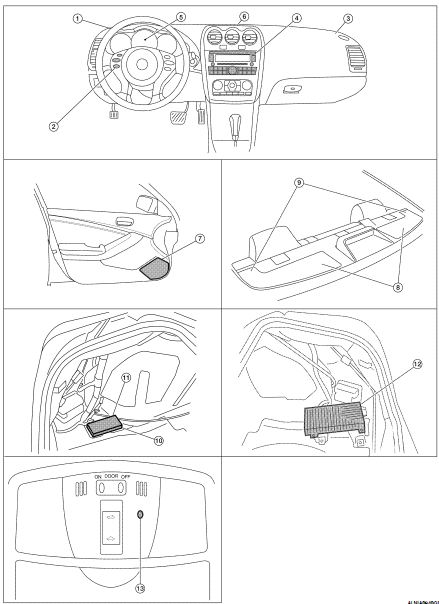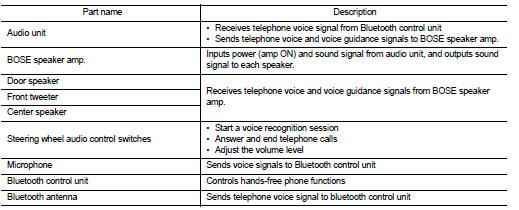Nissan Altima (L32) 2007-2012 Service Manual: Hands free phone system (coupe)
System Diagram

System Description
Refer to the owner's manual for Bluetooth telephone system operating instructions.
NOTE: Cellular telephones must have their wireless connection set up (paired) before using the Bluetooth telephone system.
Bluetooth telephone system allows users who have a Bluetooth cellular telephone to make a wireless connection between their cellular telephone and the Bluetooth control unit. Hands-free cellular telephone calls can be sent and received. Personal memos can be created using the Nissan Voice Recognition system. Some Bluetooth cellular telephones may not be recognized by the Bluetooth control unit. When a cellular telephone or the Bluetooth control unit is replaced, the telephone must be paired with the Bluetooth control unit. Different cellular telephones may have different pairing procedures. Refer to the cellular telephone operating manual.
BLUETOOTH CONTROL UNIT
When the ignition switch is turned to ACC or ON, the Bluetooth control unit will power up. During power up, the Bluetooth control unit is initialized and performs various self checks. Initialization may take up to 10 seconds.
If a phone is present in the vehicle and paired with the Bluetooth control unit, Nissan Voice Recognition will then become active. Bluetooth telephone functions can be turned off using the Nissan Voice Recognition system.
STEERING WHEEL AUDIO CONTROL SWITCHES
When buttons on the steering wheel audio control switch are pushed, the resistance in steering wheel audio control switch circuit changes depending on which button is pushed. The Bluetooth control unit uses this signal to perform various functions while navigating through the voice recognition system.
The following functions can be performed using the steering wheel audio control switch: • Initiate Self Diagnosis of the Bluetooth telephone system
• Start a voice recognition session
• Answer and end telephone calls
• Adjust the volume of calls
• Record memos
MICROPHONE
The microphone is located in the roof console assembly. The microphone sends a signal to the Bluetooth control unit. The microphone can be actively tested during self-diagnosis.
AUDIO UNIT
The audio unit receives signals from the Bluetooth control unit and sends audio signals to the speakers.
Component Parts Location

1. Front tweeter LH M51
2. Steering wheel audio control switches
3. Front tweeter RH M52
4. Audio unit M43, M44, M45, M81
5. Combination meter M24
6. Center speaker M151
7. Door speaker
LH D3
RH D103
8. Rear subwoofer
LH B25
RH B47
9. Rear tweeter
LH B16
RH B100
10. Satellite radio tuner B57, B58 (viewed with trunk carpet and LH floor spacer removed)
11. Bluetooth control unit B55, B56
12. BOSE speaker amp B121, B122 (view with trunk carpet and RH floor spacer removed)
13. Microphone R7
Component Description


 Audio system (sedan)
Audio system (sedan) Hands free phone system (sedan)
Hands free phone system (sedan)